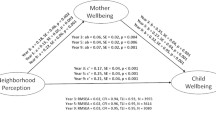Abstract
Adverse child outcomes tend to be concentrated in neighborhoods with constellations of adverse conditions and risk factors. This paper examines the challenges of developing meaningful and useful indicators of child well-being at the level of the neighborhood. Recent technological advances have made it more feasible for communities to develop neighborhood indicators, but there are a number of practical, conceptual and methodological challenges that are involved in this work. In this article, we discuss the potential usefulness of neighborhood indicators, several of the conceptual and methodological challenges and offer some illustrations of neighborhood indicators that are pertinent to the well-being of children. In addition to administrative data, we discuss indicators of child well-being rooted in both child and adult perceptions of neighborhood.
Similar content being viewed by others
References
Allard, S., Rosen, D., & Tolman, R. (2003). Access to mental health and substance abuse services among women receiving welfare in Detroit. Urban Affairs Review, 38, 787–807.
Anselin, L. (1988). Spatial econometrics: Methods and models. Boston: Kluwer Academic.
Barnes, J., Katz, I., Korbin, J. E., & O’Brien, M. (2006). Children and families in communities: Theory, research, policy and practice. West Sussex, UK: John Wiley and Sons.
Ben-Arieh, A. (2005a). Is the study of the “state of our children” changing? re-visiting after 5 years. Children and Youth Services Review, 28(7), 799–811.
Ben-Arieh, A. (2005). Where are the children? Children’s role in measuring and monitoring their well-being. Social Indicators Research, 74, 573–596.
Brooks-Gunn, J., Aber, L., & Duncan, G. (Eds.). (1997). Neighborhood poverty: Context and consequences for children. New York: Russell Sage Foundation.
Burrows, R., & Ellison, N. (2004). Sorting places out? Towards a social politics of neighbourhood informatisation. Information, Communication and Society, 7, 321–336.
Coleman, J. S. (1988). Social capital in the creation of human capital. American Journal of Sociology, 94(Supplement), S95–S120.
Coulton, C. J., Korbin, J. E., Chan, T., & Su, M. (2001). Mapping residents’ perceptions of neighborhood boundaries: a methodological note. American Journal of Community Psychology, 29(2), 371–383.
Coulton, C. J., Korbin, J. E., & Su, M. (1996). Measuring neighborhood context for young children in an urban area. American Journal of Community Psychology, 24(1), 5–32.
Coulton, C. J., Korbin, J. E., Su, M., & Chow, J. (1995). Community level factors and child maltreatment rates. Child Development, 66, 1262–1276.
Ellen, I., & Turner, M. (1997). Does neighborhood matter? Assessing recent evidence. Housing Policy and Debate, 8, 833–866.
Entwisle, B. (1991). Micro-macro theoretical linkages in social demography: A commentary. In J. Huber (Ed.), Macro-micro linkages in sociology (pp. 280–286). Newbury Park, CA: Sage.
Goerge, R., Van Voorhis, J., & Lee, B. J. (1994). Illinois longitudinal and relational child and family research database. Social Science Computer Review, 12, 351–365.
Grannis, R. (1998). The importance of trivial streets: Residential streets and residential segregation. American Journal of Sociology, 103, 1530–1564.
Heywood, D. I., Cornelius, S., & Carver, S. (1998). Introduction to geographical information systems. New York: Addison Wesley Longman.
Korbin, J. E., Coulton, C. J., Chard, S., Platt-Houston, C., & Su, M. (1998). Impoverishment and child maltreatment in African American and European American neighborhoods. Development and Psychopathology, 10, 215–233.
Lemeshow, S., Hosmer, D. W., Klar, J., & Lwanga, S. K. (1990). Adequacy of sample size in health studies. New York: John Wiley & Sons.
Leventhal, T., & Brooks-Gunn, J. (2000). The neighborhoods they live in: The effects of neighborhood residence on child and adolescent outcomes. Psychological Bulletin, 126, 309–337.
Logan, J.R., & Alba, R. D. (1993). Locational returns to human capital: Minority access to suburban community resources. Demography, 30, 243–268.
Massey, D. S. (2004). Segregation and stratification: A biosocial perspective. DuBois Review: Social Science Research and Race, 1, 1–19.
Melton, G., & Berry, F. (Eds.). (1994). Protecting children from abuse and neglect: Foundations for a new national strategy. New York: Guilford Press.
Noble, M., Wright, G., Smith, G., & Dibben, C. (2006). Measuring multiple deprivation at the small area level. Environment and Planning, 38, 169–185.
O’Brien, R. M. (1990). Estimating the reliability of aggregate-level variables based on individual-level characteristics. Sociological Methods and Research, 18, 473–504.
Pettit, K. L. S., Kingsley, G. T., & Coulton, C. J. (2003). Neighborhoods and health: Building evidence for local policy. Washington D.C.: The Urban Institute. http://www2.urban.org/nnip/health03.html.
Sabol, W., Coulton, C. J., & Polousky, E. (2004). Measuring child maltreatment risk in communities: A life table approach. Child Abuse and Neglect, 28, 967–983.
Sampson, R. J., Raudenbush, S. W., & Earls, F. (1997). Neighborhoods and violent crime: A multilevel study of collective efficacy. Science, 227, 918–924.
Sampson, R. J., Morenoff, J., & Gannon-Rowley, T. (2002). Assessing “neighborhood effects”: Social processes and new directions in research. Annual Review of Sociology, 28, 443–478.
Smith, S. K., & Cody, S. (1994). Evaluating the housing unit method. American Psychological Journal, 60, 209–221.
Spilsbury, J. (2005). “We don’t really get to go out in the front yard” – children’s home range and neighborhood violence. Children’s Geographies, 3(1), 79–99.
Spilsbury, J., & Korbin, J. E. (2004). Negotiating the dance: Social capital from the perspective of neighborhood children and adults. In P. Pufall & R. Unsworth (Eds.), Rethinking childhood (pp. 191–206). New Brunswick, NJ: Rutgers University Press. .
United Nations Human Settlements Program. (2006). http://www.unhabitat.org/programmes/guo/guo_indicators.asp.
Author information
Authors and Affiliations
Corresponding author
Rights and permissions
About this article
Cite this article
Coulton, C.J., Korbin, J.E. Indicators of child well-being through a neighborhood lens. Soc Indic Res 84, 349–361 (2007). https://doi.org/10.1007/s11205-007-9119-1
Accepted:
Published:
Issue Date:
DOI: https://doi.org/10.1007/s11205-007-9119-1



